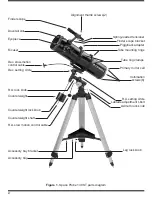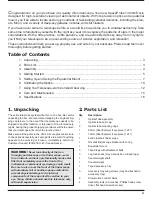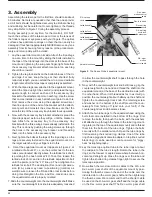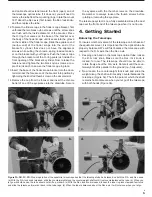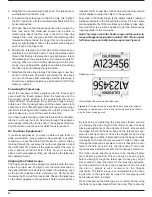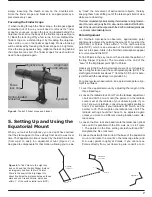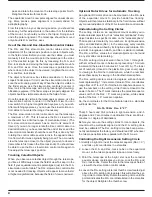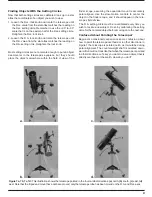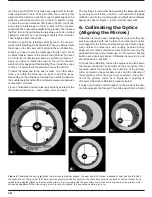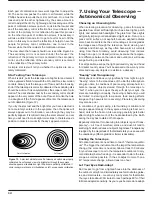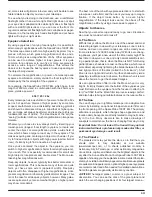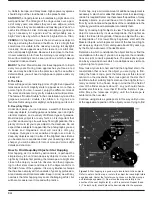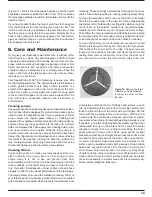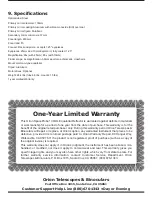
background behind the secondary mirror, making it easier to
distinguish the mirror holder from the background.
Use a Collimation Tool
To aid in centering your line of sight down the focuser draw-
tube, and in centering the mirror reflections during
collimation, it is very helpful to use a precision collimating tool
containing crosshairs, such as the Orion Collimating
Eyepiece (#3640). A laser collimator, like the Orion
LaserMate (#5680), can also be employed to obtain very
accurate optical alignment. We highly recommend that you
purchase one of these devices in order to get the best per-
formance out of your telescope.
Aligning the Secondary Mirror
With the eyepiece removed, look straight down the open
focuser drawtube at the secondary mirror. Ignore the reflec-
tions for the time being. The secondary mirror should be
centered in the field of view. If it isn’t, as in Figure 8b, it must
be adjusted. (It helps to adjust the secondary mirror in a
brightly lit room with the telescope pointed toward a bright
surface, such as white paper or a wall.)
If the secondary mirror is not centered in the focuser draw-
tube (in the direction parallel to the length of the telescope),
loosen the three set screws in the center hub of the sec-
ondary mirror holder several turns. You will need a 2mm Allen
wrench to do this. Now grasp the secondary mirror holder
with your fingers (be careful not to touch the surface of the
secondary mirror) and keep it stationary while turning the
central Phillips head screw (as in Figure 9). Turning the bolt
clockwise will move the secondary mirror toward the front
opening of the optical tube, while turning the bolt counter-
clockwise will move the secondary mirror toward the primary
mirror. When the secondary mirror is centered in the focuser
drawtube (as in Figure 8c), rotate the secondary mirror hold-
er slightly side-to-side until the reflection of the primary mirror
is as centered in the secondary mirror as it will get. It still may
not be perfectly centered yet, but that is OK. Now tighten the
three set screws to secure the secondary mirror in that posi-
tion. This adjustment will rarely need to be done, if ever.
If the entire primary mirror reflection is not visible in the sec-
ondary mirror (as it is not in Figure 8c), adjust the tilt of the
secondary mirror by alternately loosening one of the three set
screws a turn and tightening the other two (Figure 10). The
goal is to center the primary mirror reflection in the secondary
mirror, as depicted in Figure 8d. Don’t worry if the reflection
of the secondary mirror (the smallest circle, with your eye
reflected in it) is off-center (as is the case in Figure 8d); you
will fix that in the next step.
Adjusting the Primary Mirror
The final adjustment is made to the primary mirror. It will need
adjustment if, as in Figure 8d, the secondary mirror is cen-
tered under the focuser and the reflection of the primary mirror
is centered in the secondary mirror, but the small reflection of
the secondary mirror (with your eye inside) is off-center.
To access the primary mirror collimation screws, remove the
cover plate on the rear end of the optical tube (bottom of the
primary mirror cell) by unthreading the three Phillips head
screws with a screwdriver. The tilt of the primary is adjusted
with the three pairs of collimation screws (see Figure 11). The
collimation screws can be turned with a Phillips head screw-
driver and a 2.5mm Allen wrench.
11
Figure 9: To center the secondary mirror under the focuser, hold the
secondary mirror holder in place with one hand while adjusting the cen-
ter screw with a Phillips screwdriver. Do not touch the mirror's surface
Figure 10: Adjust the tilt of the secondary mirror by loosening or
tightening the three alignment set screws with a 2mm Allen wrench.
Figure 11: The back end of the optical tube (bottom of the primary
mirror cell). The three pairs of set screws and Phillips-head screws
adjust the tilt of the primary mirror.
Phillips-head screw
Set screw


